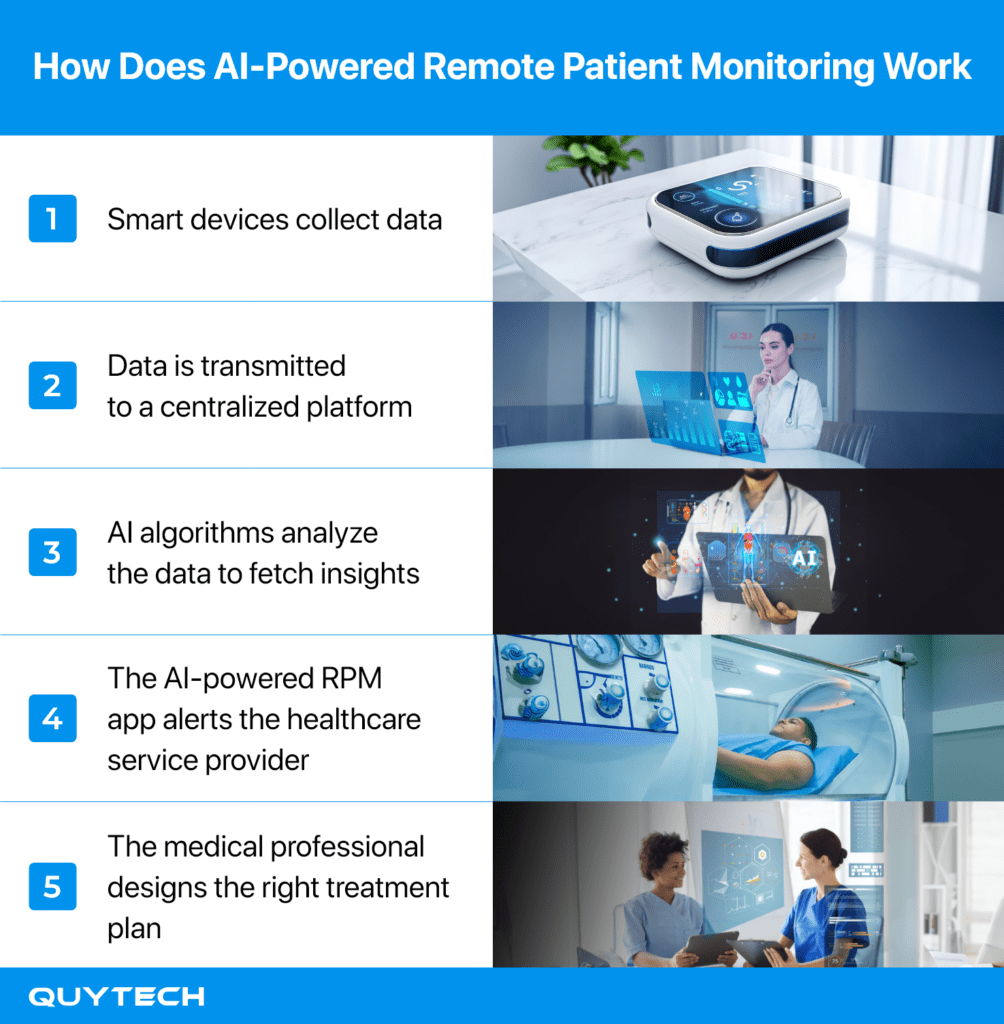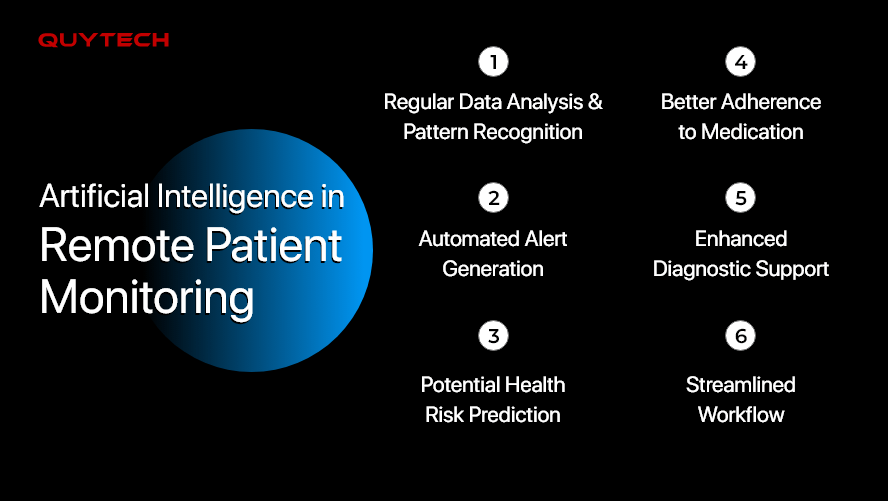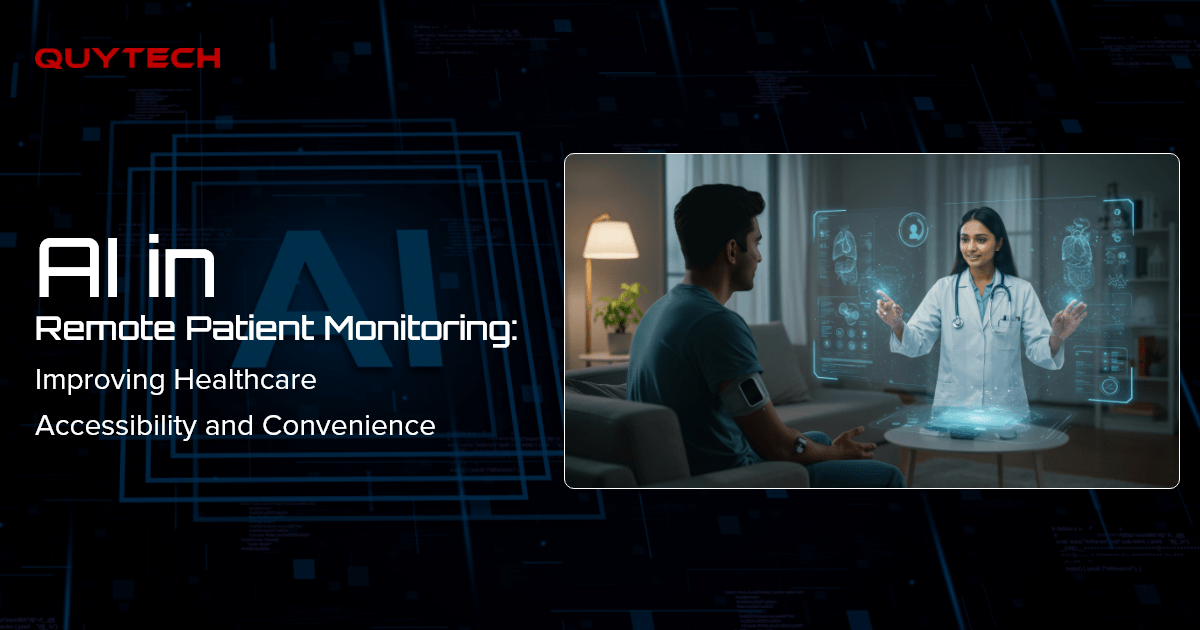There was a time when people used to visit a doctor’s clinic or hospital, and wait for hours for consultations, even in case of minor health problems or just to get their vitals checked.
The increasing adoption of technologies, mainly artificial intelligence, has changed this entire scenario by enabling patients to get their basic health check-ups and vitals monitoring (heart rate, glucose level, blood pressure, and more) done without stepping out of their homes.
All thanks to the integration of AI in remote patient monitoring, which is doing wonders for patients and healthcare professionals.
How? Let’s dig deeper into this blog that spills the beans on what remote patient monitoring is, traditional RPM vs. AI-powered remote patient monitoring, the benefits of AI-powered RPM for patients and healthcare specialists, key technologies used for AI remote patient monitoring, and a lot more.
Let’s begin!
Understanding AI Remote Patient Monitoring (RPM)
AI in remote patient monitoring includes the utilization of artificial intelligence algorithms and AI subsets, such as computer vision, machine learning, and natural language processing, to analyze the data collected from patients remotely.
AI-powered remote monitoring platforms automatically collect this data from wearable devices such as smartwatches, fitness trackers, and other digital health platforms that a user wears to track their fitness or activity levels.
The best part of AI remote patient monitoring and the applications that do the RPM is that they don’t require any manual intervention and also deliver accurate outputs. The popularity of AI patient monitoring can be understood from the statistics that highlight that its market is anticipated to reach USD 8,438.5 million by 2030.
You may like to read: How AI Is Transforming the Healthcare Industry: Discover the Top Ways
How Does AI-Powered Remote Patient Monitoring Work
Before moving ahead, let’s first go through the steps to understand how artificial intelligence remote patient monitoring works:
- Patients wear smart wearables and devices, such as watches, patches, fitness trackers, and specialized sensors to track their vitals and activity levels.
- These smart devices are connected to a centralized platform or an AI remote patient monitoring application via IoT. This data is automatically transmitted to a centralized software or application.
- AI algorithms embedded in the software analyze this data to bring critical insights, such as patterns, anomalies, and potential health risks.
- In case of any potential risk, the software or the AI-powered remote patient monitoring app raises a flag to alert the doctor or healthcare professional.
- The healthcare professional takes action by providing a personalized treatment plan.

You might be interested in: How AI Is Transforming the Healthcare Industry: Discover the Top Ways
Traditional RPM Vs. AI-Powered RPM
To understand the impact of AI-powered remote patient monitoring, take a look at the table below that clearly explains key differences between traditional remote patient monitoring and AI-powered remote patient monitoring:
| Traditional Remote Patient Monitoring Vs. AI Remote Patient Monitoring | ||
| Parameters | Traditional RPM | AI-Powered RPM |
| Data Analysis | Manual review of collected patient data | Automated collection and analysis of patient data |
| Personalization | Limited personalization | Totally personalized treatment plans |
| Intervention Timing | It reacts or shares an alert only when the health parameter goes above the defined values | Proactively anticipates potential health problems based on real-time monitoring |
| Efficiency | Consumes a lot of time | Highly efficient, as it saves time for healthcare providers |
| Patient Engagement | Relies on the manual measurements entered by patients | Better engagement because of automated measurements and personalized feedback |
| Insights & Prediction | Offers only basic data trends and limited insights | In-depth insights into patient health patterns and predictions |
Benefits of AI-Powered Remote Patient Monitoring for Patients and Healthcare Providers
AI remote patient monitoring benefits both patients and doctors/healthcare service providers. Check out the amazing advantages of AI-powered remote patient monitoring below:
For Patients
- Enhanced Convenience and Comfort
With an AI-enabled remote patient monitoring app, patients can manage their health by continuously tracking their vital signs and health indicators. They don’t even have to visit their doctor’s clinic or hospital frequently to get the same checked. This brings a lot of convenience, especially for those living in remote places or who have mobility issues.
- Personalized and Proactive Care
AI-powered remote patient monitoring apps are equipped with advanced AI algorithms that can automate the collection and analysis of patient data to identify patterns and trends. Based on these trends and patterns, healthcare professionals can design personalized care plans and adopt proactive approaches to prevent healthcare problems.
- Increased Healthcare Awareness
Remote patient monitoring powered by artificial intelligence provides patients with accurate health-related data and insights. They can actively manage their health by understanding their vitals, like blood pressure, glucose levels, sleep patterns, and more. They can make lifestyle changes and adopt healthy habits to stay healthy.
- Early Disease Detection and Timely Intervention
AI-powered RPM apps can collect data from multiple sources and provide crucial health-related insights by analyzing that data. These apps may immediately raise a flag or identify anomalies that can alert the patient and healthcare professionals to take immediate action.
- Improved Peace of Mind
By improving awareness towards health, AI-based remote patient monitoring applications and platforms give patients greater peace of mind. They can efficiently manage their healthcare conditions, especially chronic ones, with regular monitoring of vitals. It can also contribute to avoiding complications.

For Healthcare Providers
- Enhanced Efficiency and Resource Allocation
With AI-powered remote patient monitoring, doctors or healthcare providers can streamline workflows; such systems automate data collection and analysis while sending automated alerts. This frees up the doctor from the hassle of doing these tasks manually; they can focus on other strategic tasks.
- Accurate Diagnostic
AI RPM systems and applications are equipped with AI algorithms that can process vast amounts of patient data to identify crucial patterns that may not be covered during manual observation. This leads to highly accurate and timely diagnosis of health-related problems.
- Data-Driven Insights
Artificial intelligence offers medical professionals a detailed view of each patient’s health status. Professionals can use these insights to design personalized care plans for each patient. It ensures better outcomes.
- Early Detection of Health Issues
AI-powered remote patient monitoring solutions not only facilitate real-time monitoring of patients’ health indicators but also raise immediate concerns in case they find any potential risk. Based on the severity of the alert, healthcare professionals can detect health problems and take required actions in time to prevent or better treat the issues.
- Improved Healthcare Accessibility
With AI remote patient monitoring, healthcare institutions can increase accessibility to healthcare services. Even people with limited mobility or living in remote areas can regularly monitor their health signs.
The Role of Artificial Intelligence in Remote Patient Monitoring
Artificial intelligence in remote patient monitoring is revolutionizing the way patients manage their health and healthcare service providers monitor and provide care plans to patients. Let’s check out in detail:
#1 Regular Data Analysis and Pattern Recognition
AI algorithms embedded in AI-powered remote patient monitoring systems and applications can make the meaning of patient data collected from wearables, connected devices, patches, and other smart devices. They can figure out patterns based on which healthcare professionals can prepare treatment plans.
Example– An AI-powered RPM app that can analyze heart rate and other health-related data from a smartwatch. Such an app can even raise an alarm upon a sudden and sustained increase in the patient’s heart rate.

#2 Automated Alert Generation
AI remote patient monitoring software comes up with personalized alert and notification features. It can analyze each patient’s profile to understand their particular condition, disease history, and other details. It notifies the healthcare service provider only when it is necessary, unlike a manual patient monitoring system that doesn’t guarantee this much accuracy in diagnosis.
Example- An AI-powered remote patient monitoring system that monitors blood glucose levels of diabetic patients can automatically send an alert if the levels or glucose readings go dangerously low or high.
#3 Potential Health Risk Prediction
AI-enabled remote patient monitoring facilitates early detection of potential health problems. The apps and solutions made for RPM continuously analyze vital signs of the patient’s body and have the capability to identify a pattern that may lead to a health issue in the future.
Example- By analyzing vital signs, medication adherence, and test reports, AI-powered RPM systems can pinpoint those patients with a higher chance of being readmitted or experiencing a potential health problem.
#4 Better Adherence to Medication
AI-powered RPM systems can regularly send alerts and reminders to ensure the patient takes their medication regularly. It can even track and analyse adherence patterns, which can help keep health issues in control.
Example- An AI-powered RPM app can automatically send reminders to a patient’s phone at the time of taking medications.
#5 Enhanced Diagnostic Support
Remote patient monitoring powered by artificial intelligence can assist healthcare professionals with the accurate diagnosis of health issues. It can identify even subtle anomalies to offer suggestions for the patient’s health condition.
Example- A remote patient monitoring tool backed by AI has the capability to identify patterns that may indicate the early stage of diabetes and other potential problems. This can help a healthcare service provider to conduct further tests.
#6 Streamlined Workflow
When a doctor or medical professional uses AI remote patient monitoring tools to monitor the vital signs of patients, they don’t have to do it manually. This means reduced burden and improved focus on other crucial tasks.
Example- An AI-powered RPM system can help cardiologists to continuously monitor ECG data without manually intervening.
Similar Read: Top Benefits and Use Cases of AI in Healthcare
Key AI Technologies Used in RPM
When learning about AI-based health monitoring systems or artificial intelligence in remote patient monitoring, it is crucial to understand the technologies that work in the background to make this magic happen:
- Machine Learning: The technology helps in analyzing vast amounts of patient data collected from wearables, sensors, and electronic health recorders. It identifies patterns and trends, predicts health risks, detects anomalies, and more.
- Deep Learning: This technology leverages artificial neural networks to analyze complex medical image data from X-rays, MRIs, and CT Scans, process physiological signals, and understand patients’ symptoms from reports.
- Natural Language Processing: NLP enables the AI-based health monitoring systems to understand, interpret, and produce human language. The technology is also used in virtual assistants and chatbots, and to track patients’ symptoms and analyze sentiments.
- Computer Vision: The technology facilitates remote monitoring of physical therapy, monitoring minor wounds, and more.
- Predictive Analytics: Predictive analytics is used to make the most of insights extracted by ML and AI to forecast future health outcomes and the likelihood of potential problems. It can also predict hospital readmissions.
- IoT: Internet of Things technology is used to establish a connection between smart devices and facilitate secure data transmission.
Read More: The Future of Smart Hospitals: Leveraging IoT for Improved Patient Care
Examples of AI-Powered RPM Devices and Platforms
Some examples of AI-powered RPM devices and platforms include:
- Smart wearables such as smartwatches, fitness trackers, and biosensors. These devices can monitor heart rates, blood pressure, glucose levels, oxygen levels, sleep patterns, body temperature, and more.
- AI-powered blood pressure cuffs, ECG monitors, spirometers, and pulse oximeters.
- AI-enabled RPM software and solutions that offer data analytics and predictive modeling, design personalized care plans, detect anomalies, virtual assistants and chatbots, remote diagnostics, and ensure adherence to medication.
Companies like Apple, Fitbit, Ultrahuman, Oura Health, and others are already using artificial intelligence to facilitate remote patient monitoring. If you want to build such a solution or an AI remote patient monitoring app, connect with an experienced AI development company or hire AI developers.
However, if you want to develop an AI remote patient monitoring solution on your own, go through the stepwise process mentioned in the next section.
Also Read: Latest Healthcare Tech Trends in 2025 – Quytech Blog
How to Implement AI in Remote Patient Monitoring
Here is the step-by-step process for building an AI-powered remote patient monitoring solution:
#1 Define Your Objectives
The first thing to do is to mention the goal you want to achieve with your AI in remote patient monitoring app or system. The goal could be designing personalized treatment plans by keeping a tab on the patient’s vital signs, detecting deterioration at an early stage, and others. Remember, well-defined objectives lead to successful development.
#2 Prepare Data Infrastructure
AI-based remote patient monitoring systems rely heavily on data. Therefore, make sure you have a robust data infrastructure to collect, store, and manage patient data from multiple sources. Don’t forget to consider data privacy, security, and interoperability.
#3 Choose Appropriate AI Algorithms and Models
Select the right AI algorithms and machine learning techniques that ensure achieving the end goal (predicting potential health risks, anomaly detection, generating alerts, designing personalized care plans, etc.) of your AI remote patient monitoring platform.
#4 Build and Train AI Models
It’s time to create and train the AI model on the prepared patient data, which is obtained after preprocessing, feature engineering, and other processes. Make sure the data is accurate and reliable. Don’t forget to evaluate the performance of your AI model on defined metrics.
#5 Integrate AI into Existing RPM Systems
This step involves seamlessly integrating the trained AI model into your existing tech infrastructure that facilitates remote patient monitoring. Ensure the model’s compatibility with current workflows and processes.
#6 Conduct Clinical Validation and Testing
Once you integrate the AI model, validate and test the AI-powered RPM software in a real environment, i.e., a clinical setting. Test the software or RPM system for precision, trustworthiness, and other desired outcomes.
#7 Monitor and Improve
Keep updating and training the AI-powered virtual patient monitoring solution on new datasets. Also, consider patients’ and doctors’ feedback to make required changes for the long-term success of the developed AI-enabled RPM.
You may like to read: How to Develop Patient Portal App? A Detailed Guide
Final Thoughts
Artificial intelligence in remote patient monitoring is benefitting healthcare service providers and patients immensely by continuously monitoring vitals, automatically raising an alarm in case of emergency, predicting potential health problems, and in many other ways. Read this blog to know everything about AI in remote patient monitoring.
The blog delves deeper into AI in RPM, its benefits for patients and doctors, the difference between the conventional way of RPM and AI-based health monitoring systems, how AI revolutionizes RPM, and a lot more.
If you want to build an AI-powered remote monitoring system or integrate AI into your existing remote patient monitoring platform, connect with a reputed AI development company with a proven background of building similar applications or solutions.


